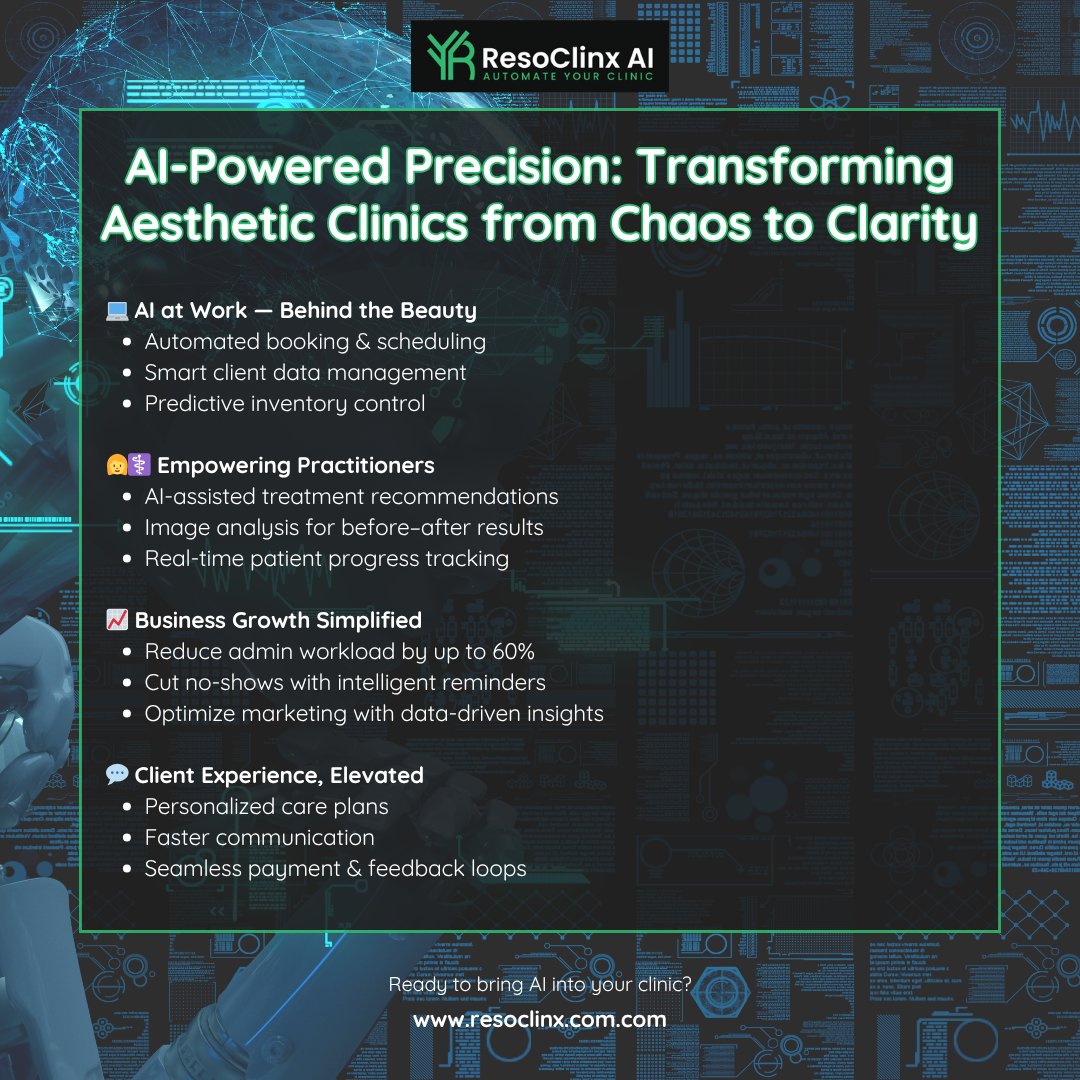Running an aesthetic clinic no longer has to mean juggling endless administrative tasks. Artificial intelligence (AI) is transforming how modern practices operate—streamlining workflows, enhancing patient care, and improving efficiency in ways that genuinely make a difference.
In this post, you’ll explore practical, real-world uses of AI for aesthetic clinics and learn how to apply them to work smarter, not harder.
Key Takeaways
- Automate admin tasks: AI can handle routine jobs like appointment reminders, record updates, and billing—reducing paperwork and human error.
- Improve efficiency: Smarter scheduling tools help minimise patient waiting times and make better use of staff and treatment rooms.
- Personalise care: AI-driven facial analysis and predictive modelling allow for more accurate, bespoke treatment plans and improved patient satisfaction.
- Set clear expectations: Predictive tools can help visualise outcomes, ensuring patients have realistic expectations before treatment begins.
- Use AI responsibly: Prioritise data security and fairness by ensuring AI systems are compliant with GDPR and trained on diverse, unbiased datasets.
Streamlining Clinic Operations With AI

Running a busy aesthetic clinic involves many moving parts, and it can often feel like there’s more to manage than time allows. From appointment bookings and patient records to billing and follow-ups, administration can quickly consume valuable hours that could be spent with patients.
This is where Artificial Intelligence (AI) becomes a game-changer—not as a replacement for your skilled team, but as a reliable assistant that keeps your clinic running efficiently. By automating repetitive, time-consuming tasks, AI frees your team to focus on what matters most: delivering exceptional patient care.
Automating Administrative Tasks for Enhanced Efficiency
The volume of administrative work in an aesthetic clinic can be overwhelming—appointment confirmations, reminders, patient file updates, and payments all demand attention.
AI-powered systems can take on much of this workload. They can automatically schedule appointments based on clinic availability, send personalised reminders by text or email, and even manage routine billing queries.
This reduces the risk of double-bookings or missed appointments and speeds up day-to-day operations. Most importantly, your front-of-house team can spend more time connecting with patients face-to-face, creating a professional yet welcoming experience.
Optimising Appointment Scheduling and Resource Allocation
Getting the right patient into the right chair at the right time is both an art and a science. AI scheduling tools analyse historical data—appointment lengths, no-show patterns, and staff availability—to build accurate, efficient timetables.
The result? Fewer empty slots, shorter waiting times, and optimal use of your clinic’s equipment and treatment rooms.
AI can even predict busy periods so you can allocate staff accordingly. This smart resource management doesn’t just save time—it boosts productivity, increases revenue, and enhances the overall patient experience.
Reducing Human Error in Daily Operations
Even the most organised teams make mistakes, and in a clinical environment, small errors can have large consequences. AI technology acts as a safety net, automatically flagging inconsistencies or missing details in patient records before they cause problems.
In billing, AI systems ensure accuracy in coding and payments, reducing delays and improving patient satisfaction.
By automating error-prone tasks, AI helps maintain high standards of accuracy and professionalism—building trust and reliability across your clinic’s operations.
Integrating AI into clinic operations isn’t about replacing the human touch—it’s about enhancing it. By handling routine and repetitive tasks, AI enables your team to dedicate more time and energy to the personal interactions that define outstanding patient care in the aesthetic industry.
Enhancing Patient Care Through AI

Artificial intelligence is revolutionising how aesthetic clinics deliver patient care, enabling more precise and truly personalised treatments. It’s not about replacing the clinician’s expertise but about enhancing your ability to achieve the best possible results for every patient.
Personalising Treatment Plans with AI Insights
AI can analyse large volumes of patient data—medical history, treatment records, and lifestyle factors—to help design care plans tailored to each individual. This allows practitioners to move beyond “one-size-fits-all” approaches and deliver targeted regimens with maximum effectiveness and minimal side effects.
Here’s how AI supports more personalised care:
- Data Analysis: AI identifies patterns and trends in patient information that might go unnoticed through manual observation.
- Predictive Modelling: It anticipates how a patient is likely to respond to specific treatments, guiding practitioners towards the most suitable options.
- Customisation: These insights lead to data-driven, bespoke treatment strategies designed around the patient’s unique profile.
By processing and interpreting complex data, AI delivers a new standard of personalisation—helping aesthetic professionals achieve safer, more consistent, and more satisfying outcomes.
The ability of AI to process and interpret complex patient information allows for a level of personalisation previously unattainable, leading to more effective and satisfying treatment journeys.
Improving Diagnostic Precision and Objectivity
When diagnosing skin conditions or assessing aesthetic concerns, AI technology offers a new level of accuracy and objectivity. Tools powered by computer vision can analyse images in remarkable detail—identifying subtle variations or early signs of skin changes that might be difficult to detect with the human eye.
While AI doesn’t replace clinical judgment, it provides an invaluable second opinion. This enhances consistency, reduces the risk of human error, and supports more data-driven decision-making in your practice.
- Image Analysis: Detects fine variations in skin texture, tone, and pigmentation.
- Condition Identification: Helps recognise early signs of ageing, inflammation, or other dermatological conditions.
- Diagnostic Consistency: Ensures a standardised, reliable approach across multiple practitioners and timeframes.
Facilitating Realistic Expectations Through Predictive Analytics
Setting and managing expectations is essential in aesthetic medicine. AI-powered predictive analytics give patients and practitioners a clearer view of potential treatment outcomes. By analysing data from similar cases and factoring in the patient’s individual characteristics, AI can forecast likely results before any procedure begins.
This level of transparency builds trust, supports informed consent, and strengthens patient satisfaction.
- Outcome Forecasting: AI models treatment results based on the patient’s unique features and selected procedures.
- Visualisation Tools: Advanced systems can generate digital previews of expected outcomes, improving patient understanding.
- Informed Decision-Making: Predictive insights help patients make confident, well-informed choices about their treatment plans.
AI-Powered Tools for Aesthetic Analysis
Technology is transforming aesthetic analysis far beyond improved cameras or imaging software. Artificial intelligence (AI) now provides clinicians with powerful tools to assess facial structure and skin health with unprecedented precision.
This isn’t about replacing clinical judgement—it’s about giving practitioners objective, data-driven insights that support more accurate and confident treatment planning.
Leveraging Computer Vision for Facial Analysis
Computer vision allows AI to “see” and interpret facial features in fine detail. In aesthetic practice, this means algorithms can evaluate symmetry, identify subtle imbalances, and map facial contours with exceptional accuracy.
The data gathered through computer vision helps practitioners establish a reliable baseline for procedures such as injectables or surgical enhancements. This objective analysis supports treatment planning that restores facial balance and natural harmony.
Utilising 3D Modelling and Augmented Reality
3D modelling technology can now create highly detailed digital replicas of a patient’s face. Using augmented reality (AR), practitioners can overlay predicted outcomes directly onto these models, allowing patients to preview possible results before treatment begins.
This visualisation capability enhances communication, builds trust, and ensures expectations are realistic—turning the consultation into a collaborative process between practitioner and patient.
Predicting Future Ageing Patterns for Preventative Care
AI tools can analyse a patient’s current skin condition and structural features to predict likely ageing patterns. Rather than forecasting the future, this analysis highlights areas prone to volume loss or fine lines, enabling clinicians to recommend preventative treatments early.
By shifting from reactive correction to proactive care, aesthetic clinics can help patients maintain their results longer and reduce the need for invasive procedures later in life. It’s a forward-thinking approach to long-term skin health and aesthetic maintenance.
The Role of AI in Treatment Planning

Artificial intelligence is transforming how aesthetic clinics develop treatment plans—replacing guesswork with precision. Rather than relying on standardised protocols, AI systems analyse each patient’s unique data to identify the most effective and safest approach.
This shift towards personalised planning leads to more predictable results, fewer side effects, and higher patient satisfaction.
Developing Hyper-Personalised Treatment Strategies
AI excels at identifying patterns within complex patient data—skin type, genetic predispositions, lifestyle habits, and previous treatments. By interpreting this information, it enables practitioners to design care plans that are genuinely bespoke.
For example, modern tools can assess skin hydration, texture, and elasticity to recommend targeted skincare regimes or in-clinic treatments. This data-driven methodology reduces trial and error, saving time while improving consistency of outcomes.
Shifting Towards Biologically-Based Treatments
AI helps clinics move beyond generic treatment protocols. By cross-referencing vast datasets—including biological markers and lifestyle data—it supports recommendations aligned with each patient’s natural physiology.
This approach results in more predictable improvements with fewer unwanted reactions, reinforcing a science-led philosophy of aesthetic care that works with the body rather than against it.
Ensuring Inclusivity in AI Training Data
AI’s accuracy depends on the quality and diversity of the data it learns from. If training datasets lack representation across age, ethnicity, or skin tone, results may be biased or less effective for certain groups.
For aesthetic practitioners, inclusivity isn’t optional—it’s essential. Choosing AI solutions trained on diverse, well-audited datasets ensures fair, reliable outcomes for every patient. Ethical implementation also aligns with UK GDPR and professional standards for data protection.
Integrating AI for Improved Patient Experience

Artificial intelligence is reshaping how aesthetic clinics connect with their patients—enhancing not only efficiency but also the quality of every interaction. Beyond streamlining operations, AI is now central to improving communication, accessibility, and overall patient satisfaction.
AI-Driven Chatbots for Patient Inquiries
Patients often have similar questions about appointment availability, pre-treatment instructions, or general service details. Handling these manually takes time and resources that could be better spent elsewhere.
AI-powered chatbots provide instant, accurate answers 24/7—offering support when patients need it most. Far from being impersonal, modern chatbots can be customised with your clinic’s tone, service details, and FAQs to act as a seamless extension of your front-desk team.
Key benefits include:
- Instant responses: Available around the clock to answer questions immediately.
- Reduced staff workload: Frees up reception and practitioners to focus on patient care.
- Consistent information: Delivers reliable, uniform messaging every time.
- Scalability: Handles large volumes of enquiries efficiently, even during peak periods.
By offering immediate, professional assistance, chatbots reduce patient anxiety and create a smooth, stress-free first impression before the consultation even begins.
Chatbots can be trained on your clinic’s specific services, pricing, and policies, making them a personalised extension of your front-desk team. They can even guide patients to the right resources on your website or suggest booking a consultation if their query is more complex.
Streamlining Follow-Up Processes
Patient care doesn’t end when the treatment does. Consistent and thoughtful follow-up strengthens trust and encourages loyalty.
AI can automate and personalise post-treatment communication—sending tailored care instructions, scheduling follow-up reminders, or checking in on recovery progress. This not only enhances satisfaction but also ensures continuity of care long after the patient leaves the clinic.
Practical AI applications for follow-up include:
- Personalised aftercare: Automatic post-treatment advice based on procedure type.
- Proactive check-ins: Routine messages to monitor recovery and resolve minor issues early.
- Smart reminders: Automated prompts for review appointments or future treatments.
- Feedback collection: Timely requests for reviews or testimonials to support your clinic’s online reputation.
Automated yet personal, these systems demonstrate that your clinic genuinely cares about patient wellbeing—improving both outcomes and retention.
Enhancing Accessibility with Virtual Assistants
AI-powered virtual assistants take automation a step further. They can guide patients through bookings, help them find information, and even collect pre-consultation details securely.
This technology improves accessibility for patients who live far away, have limited mobility, or simply prefer digital interactions. By removing barriers to care, your clinic becomes more inclusive, modern, and responsive to patient needs.
| Feature | Traditional Method | AI-Powered Virtual Assistant |
|---|---|---|
| Information Access | Phone calls or emails | Instant, conversational support |
| Booking Process | Manual or web forms | Real-time scheduling with availability checks |
| Patient Support | Limited to clinic hours | 24/7 responses to common queries |
| Personalisation | Generic communication | Tailored advice with patient consent and history |
By embracing virtual assistants, aesthetic clinics can deliver a more seamless and patient-centred experience—one that aligns with the expectations of today’s digitally savvy clientele.
Navigating Challenges in AI Adoption
While AI offers powerful opportunities for aesthetic clinics, successful adoption depends on addressing a few key challenges responsibly. Integrating AI thoughtfully—not hastily—ensures that your clinic benefits from innovation while maintaining ethical, safe, and compliant standards of care.ickly.
Addressing Ethical Concerns and Algorithmic Bias
Fairness and inclusivity are essential in any AI system. Because AI learns from the data it’s trained on, unbalanced or limited datasets can lead to biased results. In aesthetic applications, this might translate into inaccurate analysis for patients with darker skin tones or diverse facial features.
Clinics should prioritise AI tools that have been independently audited for bias and developed with diverse, representative data. Partnering with ethical technology providers ensures that every patient receives accurate and equitable assessments—regardless of age, gender, or ethnicity.
Ensuring Data Privacy and Security
AI platforms often handle highly sensitive patient information, including images and medical details. Protecting this data must be a top priority. Clinics should implement robust security measures, including end-to-end encryption, secure storage, and controlled access.
Compliance with UK GDPR and ICO guidelines (Information Commissioner’s Office) is not just recommended—it’s a legal requirement. Patients must have full confidence that their personal data is handled transparently, securely, and in line with UK data protection laws.
Developing Standardised Guidelines for AI Deployment
As AI becomes more integrated into aesthetic practice, establishing industry-wide standards is critical. AI should always act as a support tool, enhancing—rather than replacing—clinical judgment.
Professional bodies, developers, and healthcare regulators should collaborate to create transparent, evidence-based guidelines that define best practices for AI implementation. Clear protocols around data handling, algorithm transparency, and patient consent will ensure safe and responsible AI adoption across the aesthetic field.
Looking Ahead: AI as a Partner in Clinic Operations
Artificial intelligence is no longer a glimpse of the future—it’s the foundation of modern, patient-centred aesthetic care. By adopting AI today, clinics position themselves ahead of the curve, offering smoother operations, better-informed decisions, and more personalised experiences.
The key is to start small and stay curious. Whether it’s automating admin tasks or enhancing consultations, every step towards AI integration strengthens your clinic’s efficiency, professionalism, and long-term growth.
AI isn’t here to replace your expertise—it’s here to refine it.
Frequently Asked Questions
How can AI make my clinic run more smoothly?
AI can take care of repetitive administrative tasks such as scheduling appointments, sending reminders, and updating patient records. By automating these processes, your team can focus on patient care—reducing paperwork, minimising errors, and improving overall efficiency.
Can AI really help me understand my patients better?
Yes. AI analyses detailed patient data—from treatment history to skin analysis—to create tailored treatment recommendations. It can even predict likely outcomes, helping practitioners and patients align on expectations before treatment begins.
What types of AI tools are available for facial and skin analysis?
Modern AI tools use computer vision to measure facial symmetry, detect early signs of ageing, and assess skin condition. Some systems incorporate 3D modelling and augmented reality (AR), allowing patients to preview potential results before treatment and supporting more transparent consultations.
How does AI assist in treatment planning?
By analysing genetics, lifestyle, and previous treatments, AI generates highly personalised treatment plans. This evidence-based approach ensures better outcomes and reduces the risk of side effects by aligning therapies with the patient’s unique biological profile.
Can AI improve the patient experience?
Absolutely. AI-powered chatbots and virtual assistants provide instant support, manage follow-ups, and send aftercare reminders. This enhances communication, reduces waiting times, and ensures patients feel supported at every stage of their aesthetic journey.
What are the key challenges when introducing AI into a clinic?
Responsible use is essential. Clinics must ensure AI tools are trained on inclusive datasets, audited for bias, and compliant with GDPR data protection standards. Transparency, fairness, and security are fundamental to building patient trust while using AI ethically.






